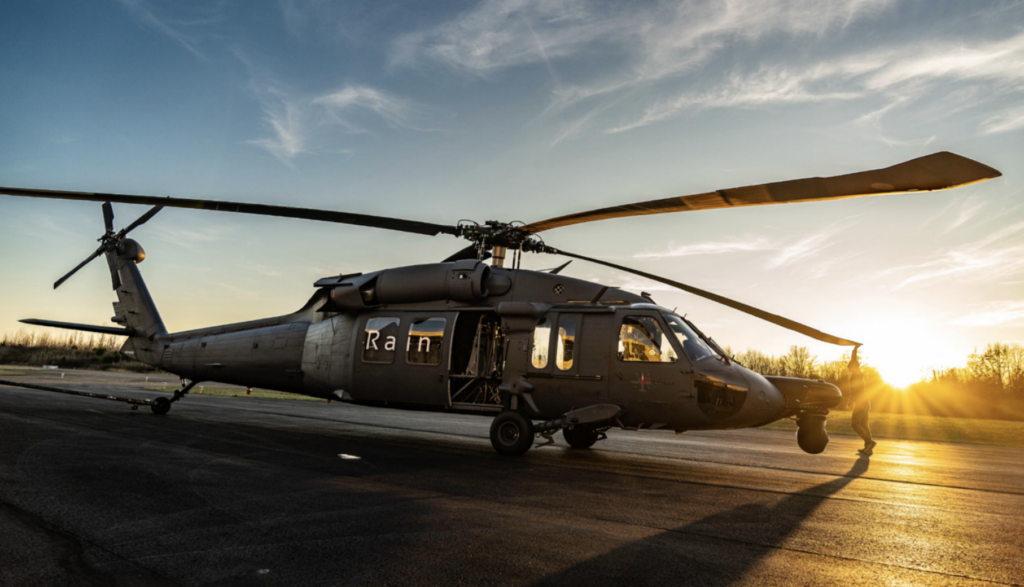
Rain Aero, a company specializing in advanced aviation technologies for firefighting, has successfully developed remote operation kits for both small rotorcraft drones and full-sized Black Hawk helicopters, aiming to strategically deploy a fleet of drones to dispense fire retardant ahead of wildfires in high-risk areas across California. (Photo: ANDREA DUNLAP / RAIN)
Rain Aero, a California-based company using advanced aviation technologies to fight wildfires, has successfully equipped both a small rotorcraft drone and a full-sized Black Hawk helicopter with a kit that allows remote operation.
The company has plans to outfit a fleet of drones, based strategically where fires most often erupt around California, where they can be automatically alerted and remotely deployed to dispense fire retardant ahead of advancing flames, Rain’s Chief Executive Maxwell Brodie said.
“We are building this technology as an integration kit to bring to existing aircraft and existing platforms,” Brodie said during a webinar hosted by the Helicopter Association International. “We want to be able for our fire agency customers to be able to bring their own aircraft to us and for us to be able to upgrade them as it relates to the broader community here. This technology is of course able to help in the interim between now and when it’s deployed in increasing safety.”
Rain just “put a wrap on” its smaller in-house platform, a small remotely operated single-main-rotor drone called the Mosquito. These aircraft are specifically designed to disperse fire retardant spray on the ground ahead of advancing firelines, Brodie said. They are not big enough to operate in the high winds that often attend large fires and have to operate too low to the ground for their downwash not to actually fan the flames while attempting to fight fires directly, he said.
It also has integrated the remote piloting kit onto a Black Hawk, which already has flown—with safety pilots aboard—while being controlled by the company’s remote crew in Alameda, California. Eventually, large, water-carrying aircraft could fly during the day and at night using similar technologies to either fly with no crew on board or to assist the crew with complex mission management tasks.

(Photo: RAIN)
“The technology that powers the mosquito translates to larger aircraft as well,” Brodie said. “So there’s nothing fundamental about the technology that’s different between the mosquito and the larger platforms like the Black Hawk that would prevent, say the Black Hawk from operating at night as well in an uncrewed manner. The capabilities that we have demonstrated to date have not included night operations, but it’s something that we’re very keen to work on as we bring the technology towards commercialization.”
Brodie would not comment on where the fundamental remote operation technology—which also includes elements of autonomous flight controls—originated. But it sounds a lot like what Sikorsky is doing with its MATRIX technology. Envisioned as a sort of digital co-pilot, MATRIX takes over many of the mundane, routine elements of flight management and assists a pilot with flying the aircraft, to the point that a full-sized helicopter can be operated by a single tablet computer.
Last year, the Army, working with Sikorsky and the Defense Advanced Research Projects Agency (DARPA) successfully integrated MATRIX, through the Aircrew Labor In-Cockpit Automation System, or ALIAS, program onto its own UH-60 Black Hawk. That helicopter has flown remotely with no personnel on board.
“It’s a very exciting time to be in this space at this time, because these aircraft automation platforms have existed and emerged and have benefited from nearly two decades worth of maturation,” Brodie said. “We are not building soup to nuts here. There’s so many giants that we’re able to partner with and add capacity or capabilities to, so the short version is it’s an exciting time to be working in a space where there are multiple aircraft automation platforms that are supporting legendary aircraft like the Blackhawk.”